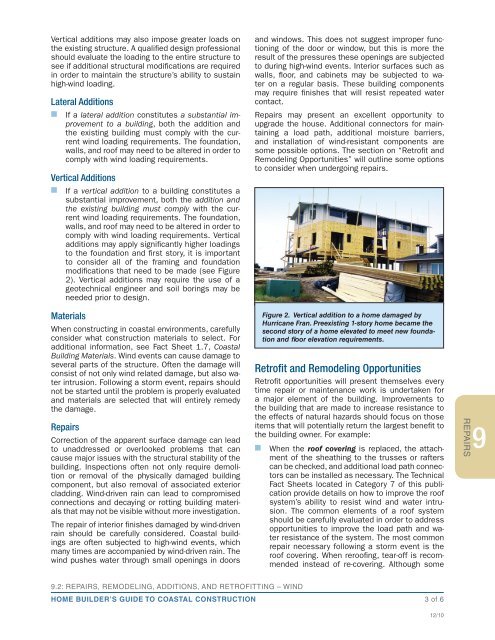FEMA P-499: Home Builder's Guide to Coastal Construction
FEMA P-499: Home Builder's Guide to Coastal Construction
FEMA P-499: Home Builder's Guide to Coastal Construction
You also want an ePaper? Increase the reach of your titles
YUMPU automatically turns print PDFs into web optimized ePapers that Google loves.
Vertical additions may also impose greater loads on<br />
the existing structure. A qualified design professional<br />
should evaluate the loading <strong>to</strong> the entire structure <strong>to</strong><br />
see if additional structural modifications are required<br />
in order <strong>to</strong> maintain the structure’s ability <strong>to</strong> sustain<br />
high-wind loading.<br />
Lateral Additions<br />
n If a lateral addition constitutes a substantial improvement<br />
<strong>to</strong> a building, both the addition and<br />
the existing building must comply with the current<br />
wind loading requirements. The foundation,<br />
walls, and roof may need <strong>to</strong> be altered in order <strong>to</strong><br />
comply with wind loading requirements.<br />
Vertical Additions<br />
n If a vertical addition <strong>to</strong> a building constitutes a<br />
substantial improvement, both the addition and<br />
the existing building must comply with the current<br />
wind loading requirements. The foundation,<br />
walls, and roof may need <strong>to</strong> be altered in order <strong>to</strong><br />
comply with wind loading requirements. Vertical<br />
additions may apply significantly higher loadings<br />
<strong>to</strong> the foundation and first s<strong>to</strong>ry, it is important<br />
<strong>to</strong> consider all of the framing and foundation<br />
modifications that need <strong>to</strong> be made (see Figure<br />
2). Vertical additions may require the use of a<br />
geotechnical engineer and soil borings may be<br />
needed prior <strong>to</strong> design.<br />
Materials<br />
When constructing in coastal environments, carefully<br />
consider what construction materials <strong>to</strong> select. For<br />
additional information, see Fact Sheet 1.7, <strong>Coastal</strong><br />
Building Materials. Wind events can cause damage <strong>to</strong><br />
several parts of the structure. Often the damage will<br />
consist of not only wind related damage, but also water<br />
intrusion. Following a s<strong>to</strong>rm event, repairs should<br />
not be started until the problem is properly evaluated<br />
and materials are selected that will entirely remedy<br />
the damage.<br />
Repairs<br />
Correction of the apparent surface damage can lead<br />
<strong>to</strong> unaddressed or overlooked problems that can<br />
cause major issues with the structural stability of the<br />
building. Inspections often not only require demolition<br />
or removal of the physically damaged building<br />
component, but also removal of associated exterior<br />
cladding. Wind-driven rain can lead <strong>to</strong> compromised<br />
connections and decaying or rotting building materials<br />
that may not be visible without more investigation.<br />
The repair of interior finishes damaged by wind-driven<br />
rain should be carefully considered. <strong>Coastal</strong> buildings<br />
are often subjected <strong>to</strong> high-wind events, which<br />
many times are accompanied by wind-driven rain. The<br />
wind pushes water through small openings in doors<br />
9.2: REPAIRS, REMODELING, ADDITIONS, AND RETROFITTING – WIND<br />
HOME BUILDER’S GUIDE TO COASTAL CONSTRUCTION<br />
and windows. This does not suggest improper functioning<br />
of the door or window, but this is more the<br />
result of the pressures these openings are subjected<br />
<strong>to</strong> during high-wind events. Interior surfaces such as<br />
walls, floor, and cabinets may be subjected <strong>to</strong> water<br />
on a regular basis. These building components<br />
may require finishes that will resist repeated water<br />
contact.<br />
Repairs may present an excellent opportunity <strong>to</strong><br />
upgrade the house. Additional connec<strong>to</strong>rs for maintaining<br />
a load path, additional moisture barriers,<br />
and installation of wind-resistant components are<br />
some possible options. The section on “Retrofit and<br />
Remodeling Opportunities” will outline some options<br />
<strong>to</strong> consider when undergoing repairs.<br />
Figure 2. Vertical addition <strong>to</strong> a home damaged by<br />
Hurricane Fran. Preexisting 1-s<strong>to</strong>ry home became the<br />
second s<strong>to</strong>ry of a home elevated <strong>to</strong> meet new foundation<br />
and floor elevation requirements.<br />
Retrofit and Remodeling Opportunities<br />
Retrofit opportunities will present themselves every<br />
time repair or maintenance work is undertaken for<br />
a major element of the building. Improvements <strong>to</strong><br />
the building that are made <strong>to</strong> increase resistance <strong>to</strong><br />
the effects of natural hazards should focus on those<br />
items that will potentially return the largest benefit <strong>to</strong><br />
the building owner. For example:<br />
n When the roof covering is replaced, the attachment<br />
of the sheathing <strong>to</strong> the trusses or rafters<br />
can be checked, and additional load path connec<strong>to</strong>rs<br />
can be installed as necessary. The Technical<br />
Fact Sheets located in Category 7 of this publication<br />
provide details on how <strong>to</strong> improve the roof<br />
system’s ability <strong>to</strong> resist wind and water intrusion.<br />
The common elements of a roof system<br />
should be carefully evaluated in order <strong>to</strong> address<br />
opportunities <strong>to</strong> improve the load path and water<br />
resistance of the system. The most common<br />
repair necessary following a s<strong>to</strong>rm event is the<br />
roof covering. When reroofing, tear-off is recommended<br />
instead of re-covering. Although some<br />
3 of 6<br />
12/10<br />
REPAIRS<br />
9


